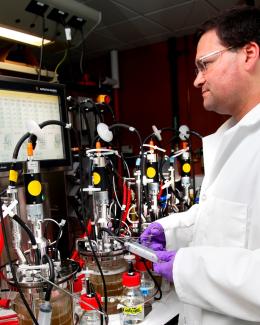Abstract
Microbial electrolysis of an aqueous phase generated from catalytic pyrolysis of pine sawdust was investigated for renewable hydrogen production. The microbial electrolysis cell (MEC) performance was investigated at an organic loading rate ranging from 2 to 50 g/L-day. A maximum hydrogen productivity of 5.8 ± 0.18 L/L-day was obtained, however, the productivity increased linearly only up to a loading rate of 10 g/L-day. The highest current density achieved was 6.8 ± 0.1 A/m2. The efficiency of conversion of the substrate to current in the anode decreased with increasing loading, but the initial maximum Coulombic efficiency was 98 ± 0.04%. The cathode efficiency, on the other hand, increased with loading up to a maximum of 89 ± 1.4%. Total hydrogen recovery was relatively constant for most runs at 30%, which is equivalent to an yield of 0.6 moL H2/mole COD, except at the highest loading rate. The operation of the MEC under batch mode, however, resulted in a higher hydrogen recovery of 63 ± 4%. The conversion of a wide range of compounds, including carboxylic acids, anhydrosugars, furanic and phenolic compounds present in the aqueous phase is reported. The results demonstrate potential for hydrogen production from a waste stream which can improve the total biofuel or energy yield of the biorefinery.


